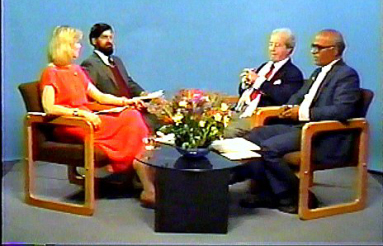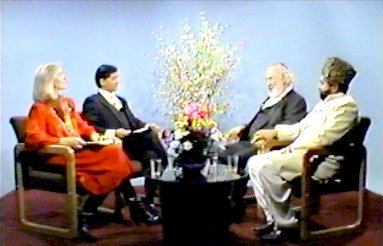Traveling in Kashmir, India
Embrace Foundation is a non-profit,
educational foundation set up to create
better understanding between people of
different religions, cultures, traditions and
world philosophies.
Embrace Foundation works to bring leaders
and scholars of world-wide religions,
cultures and philosophies together by
sponsoring forums, seminars, lectures and
developing an international exchange
program. Embrace Foundation is particularly
concerned with reaching the world public
through the media.
Purpose
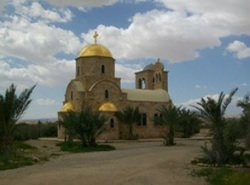
Donations
Embrace Foundation is an all volunteer
organization. All donations go directly to
programs.
Embrace Foundation does not and has
never given permission to any outside
organization to solicit or receive
contributions on our behalf.
All donations should be made to Embrace
Foundation only via Paypal or by mail. All
donations are tax deductible. A receipt will
be emailed to you. Please click on the Pay
Pal link below to Donate.
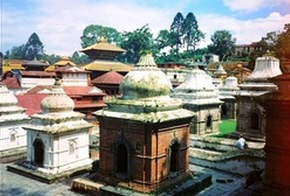
Travel As An Interfaith Act
Embrace encourages all who can do so, to
learn about other traditions and cultures by
traveling as “Grassroots Diplomats.” We
hope that people every where become life
long students of our world-wide humanity.
“ In every man there is something wherein I
may learn of him, and in that I am his pupil.”
R.W.Emerson
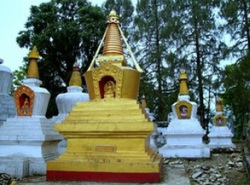

Embrace Humanity

Great Visions - TV
Guests are: Swami Satchidananda &
the Rt. Reverend Dean Parks Morton
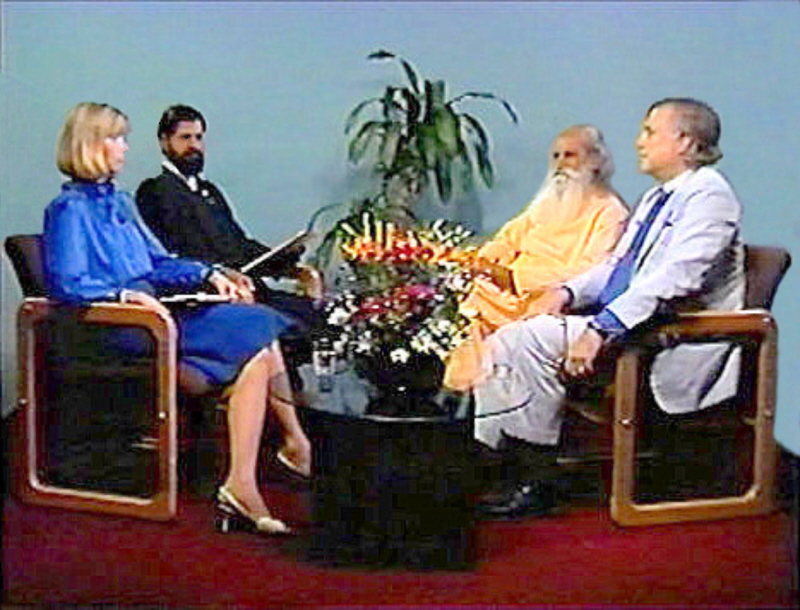
Embrace Archives
Limited Editions Gallery
Umrah - Jordan
Embrace Sacred Places
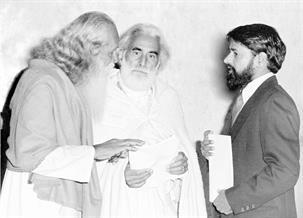
Monastery of Bahira - Syria
Embrace Foundation Universal
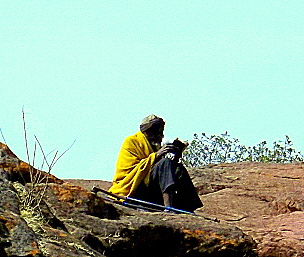
Monk Reading - Ethiopia
Thank you for making a donation.
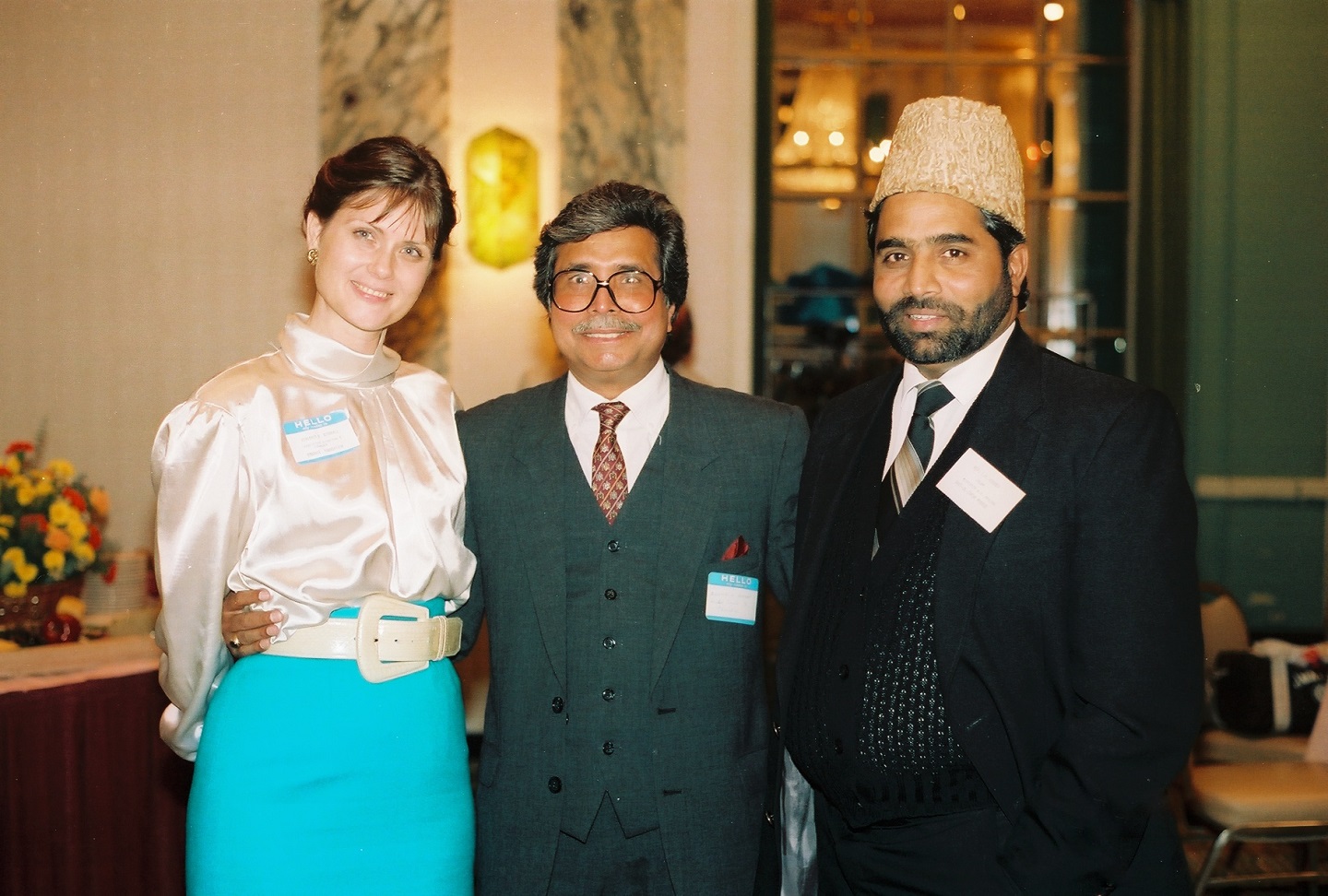
Virginia (Embrace), Dr.Anwar Barkat (World Council of Churches, UN) & Imam I.H. Kauser
Embrace Archives
Great Visions TV
Anne-Stuart & Ajata (Hosts), with Rabbi Gelberman & Dr.Jayaraman
Anne-Stuart & Ajata (Hosts), with Rabbi Carlebach & Imam Kauser
Embrace Foundation International
- Great Visions TV
- Inspirations
- Media
- Possibilities
- Astrophysics, Quantum Physics & The Nature of Reality
- Deconstructing Nuclear Fission & Nuclear Waste
- Defense Industry as Community Builders
- Defense Industry As Energy Providers
- Global Water Shortages
- Innovative Technology
- Intelligent Communities & Development
- Pentagon & Non-Western Nations
- Recreating
- Resource Based Population
- Sharing Community Resources
- Protecting Human Rights
- Spiritual Ecology
- Syria
- Write to Us
MEET THE KASHMIRIS
Islamic Kashmiri People Are Unique
It is important to understand that the people of Kashmir, despite the majority being Islamic are very distinct in culture and in
values from the people in Pakistan and Afghanistan.
However, this year, for the first time ever, Ajata and Virginia came across Jains in Kashmir, so even Kashmir is becoming
more multicultural, despite many Hindu families having left under duress.
More than Pakistan, Afghanistan and Bangladesh, the spiritual psyche of most villagers and many city dwellers has been
and continues to be integrated with the Sufi community. In fact, it appears that despite the long duration of visitations of
very conservative missionaries (even in 1982 when the Embrace Founders were first there), the proliferation of Sufis has
increased throughout many villages. It appears that there are few villages nowadays without a Pir. (It needs to be noted
however, that villagers give the appellation of “Pir” to village healers and people they revere who may not indeed be people
trained in any Sufi tradition, whether initiated, as apprentice to an elder Sufi (one-on-one) or part of a larger Sufi order, some
which extend all over Asia, the Middle East, North Africa and now in Western countries.) However, some sufis seem to
originate out of nowhere, just as some Hindu saints, such as Ramana Maharishi and Sri Ramakrishna were never part of
any organized religious tradition.
The Sufi community worldwide has never made a distinction between Shi'ah and Sunnis or any other Islamic divisions, so
they have a palliative effect on geographical areas encompassing various sects.
(Read: http://kashmirnarrator.com/shia-sunni-tensions-kashmir-real-manufactured/)
In addition, Kashmir has for some reason produced an amazing nurturing environment for mystics known as Madzubs.
Madzubs are considered “God-Intoxicated” individuals that have lost their sense of individual identity and ego in the “Divine.”
These people are known far and wide for the miracles that follow in their wake. (Such Beings are known as Avadhutas in
the Hindu tradition.)
Kashmiri Aesthetics
The Kashmiris are notable for having a long history of appreciation for beauty in all forms, a talent to create beauty and a
strong desire to live in the midst of beauty; which has been evidenced in intricate woodwork, large pieces of crewel
(embroidery), beautiful paper mache, naqash (silversmithing), pashmina shawls and fully handmade carpets among many
other arts. Prior to the political upheaval, Kashmiris also took pride in commercial (gardens in front of businesses), private
gardens, including lush floating gardens on Dal Lake and in construction design (charming houseboats among their
inventory.) Many of these arts are attributed to Sufi Sheikh Shah I Hamdan who brought knowledge of many crafts to the
Kashmiris from Hamdan, Iran.
Saudi Influence & Defiance
Street Apparel & Beards
You will see nowadays a minority of women in black abayas rather than the flowered Kashmiri kurda and pajamas, or
shalwar kamiz. It can be a sign of defiance, (just as the many large black beards worn by most young Islamic men) or it
can be due to the male military presence everywhere. The military being what it is in areas of conflict, can present a safety
problem for local women. Some women no doubt feel that if they do not draw attention to themselves, they can feel safer
traveling about alone.
A certain amount of Saudi government influence (not Saudi grassroots people) exists as a possible violent counterpoint to
the violence that has occurred against Kashmiri civilians.
Virginia flew to Srinagar seated next to a gentle, unassuming young man (an empty seat between them) with a black beard
probably twice as large as his thin neck, who had just returned from Umrah (Hajj - Pilgrimage undertaken at a time other
than the month of Dhul Hajj) in Saudi Arabia. He had spent a year in the country. Virginia asked him if he had attended a
Madrassa or was becoming an Iman. “No” he said and then he used the Sanskrit word for scholar, he was becoming a
“Pundit.” The Founders later concluded he was probably studying Islamic jurisprudence - usul al-fiqh.
The young man was proud to show photos on his mobile phone of his family, his family home, his girlfriend and the
incredible snow surrounding their town this year. In the process, Virginia saw a photo of something like a person with a
disease and she asked what it was. It was a photo of a human back with dozens of what looked like red bullet holes. It
turned out it was a back that had been sprayed with pellets. It was then the young man said that nearly 138 people in his
area had been blinded or had eye damage from pellet guns shot into crowds of civilians. This was only the beginning of an
odyssey of hearing stories unprompted from young men with large black beards.
Kashmiri Merchants & the Desire for Business
The Founders heard over and over again from merchants along Dal Lake how the Indian (Hindustan) media has
exaggerated the terrorist threat and has literally destroyed the tourist industry, beginning in 2001 due to 9/11.
They felt they had been unjustly punished and continue to be punished for fears attached to Afghanistan and Pakistan.
In point of fact, the Indian media say that (for instance) the Bandipur area is one of the most troubled areas. Yet, for the
Founders, waiting for a van in Bandipur, after the initial slight suspicion, once the locals understood that they were on their
way to meet a rural Pir, were offered a ride by young men at a little corner shop willing to stop everything they were doing to
take both Founders on a small motor cycle along a rough dirt road of over 10 miles.(!) The generosity of the Kashmiri
people can be staggering.
In Kashmir just about everyone wants the tourist industry back. But it is not so easy. Even in 1982 some (not all)
young unmarried men had a difficult adjustment in seeing European girls in bathing suits swimming in Dal Lake. Women in
many Kashmiri Islamic families would never expose anything more than their ankles, feet, necks, hands and faces (and
traditionally in Kashmir, ears show.) On the other hand, the many Hindu honeymooners from India, although not as wealthy
as Westerners, were culturally much closer to and very comfortable with the more conservative members of Kashmir’s
Islamic community in dress and behavior.
As Westerners are getting poorer and less and less of them are traveling to non-Western nations, it appears any hope of
getting large numbers of them as tourists again seems unlikely. Yet the increasingly mobile Indian middle class to the
South and people from all of Southeast Asia would be the perfect match. As it is now, numerous Indians to the South adore
traveling to Kashmir during the snow season.
Can the Indian Government Do Anything to Improve the Situation?
What About Low Interest Loans:
Helping business men (and women) renovate and upgrade Kashmir’s tourist destinations by giving low interest loans
from the State Bank of India to help get the tourist and crafts economy going again and defray the cost of advertising?
The people in a small village told the Founders how the Indian government had promised 25 years ago to assist them in
developing a fishing and trekking center for tourists. Absolutely nothing has been done despite their successful fish farm.
The people in this small village want trekkers and campers. They want to earn a living. The villagers had been promised
by politicians again and again yet nothing in 25 years has ever happened. The area is stunning and many people
both from lower India and elsewhere would love it.
Possibilities: Thinking in New ways
Intellectual & Learning Opportunities
The Kashmiri general public is isolated from much of the technological and scientific excitement going on in the rest of
India. Free learning events that include new ideas for both youngsters and adults could greatly benefit the city of Srinagar.
Srinagar needs some ways that people can also have social outings and exchange ideas with the India that lies south of
them.
1.) Could a cultural arts exchange program between people in Kashmir and some of India’s cities be created? Could
Bhartiya Vidya Bhavan design a venue?
2.) Could scientists from ISRO produce a special program exhibiting new Mars photos and showing a video on footage
from MOM and other prob travels in Srinagar, inviting the general public for free?
3.) What about some researchers from IIT? Is anyone doing some interesting projects that the general public in Srinagar
would find exciting? Could IIT staff show an exhibit or video and speak on the research?
4.) What about scholarships offered to low income Kashmiri students to intern at ISRO or audit summer classes at
IIT?
Where Are the Pakistanis?
Kargil - Shi'ahs, sufis and Illegal Pakistanis (Ladakh Region)
The Indian media is always in an uproar over the Pakistani ISI (intelligence agency) involvement in Kashmir but who is it that
is that is really behind Pakistan with regard to weapons and assistance in Kashmir?
The Embrace Founders did not encounter any Pakistanis in Srinagar or outlaying Kashmir areas (no doubt they are there.)
However, while on our way to Leh, Ladakh by car the Founders stopped over night in Kargil. From Kargil through Leh it is
primarily Shi'ah. Surprisingly while walking up the Main Street which has been dubbed Khomeini Street, the Founders saw
many newly arrived Pakistanis (who appear to be Sunni.) They seem to be poor rural people, sort of in shock.
If they were planning any terrorist trouble in Kargil, dominated in no small way by Shi'ahs, Kargil would not be the place to
land.
On the way back down Khomeini Street after dinner, Virginia heard some one calling her. She thought that it could not
possibly be the case, as no one knew the Founders would be going to Kargil, except their wonderful driver. None-the-less,
she turned around and behind her was a kindly gentleman. He explained that he was of the Chistiya Sufi Order and wanted
to know how long the Founders would be in town and wished to invite them for a visit and zikr (dhikr). She told Mohamed
that she and Ajata would be leaving in the morning. After asking her a few questions, he said he was so pleased to have
met her, shook her hand and thanked her.
(The Embrace Network of websites seem to have found their way to Kargil.)
After returning to the inn, Virginia encountered another guest who was a forensic doctor from Srinagar. He was in town to
investigate some suspicious deaths. (Though unfamiliar with the incident, the deaths were evidently well known and
publicized.) In the course of the conversation, she mentioned to the doctor that there are so many Pakistanis in Kargil. The
doctor said, “Yes” nodding his head and guided her to a window and pointed to a cleavage high in the mountains saying;
“That is where they come from.”
Conclusion
If keeping possible terrorists out of Kashmir and Ladakh is a priority, it seems that the army bases located all along the road
between Srinagar and Leh could be largely abandoned and rebuilt along the base of mountain ranges. Having less military
standing on streets with rifles would definitely begin to normalize Srinagar. From the limited observation of two non-military,
non-strategists, it appears that once anyone hikes over any number of accessible points in the mountains, they can easily
disappear into Kashmir as well as Ladakh. However, from the point of view of terrorism, it is unlikely that Sunni militants
would ever opt to place themselves in the overwhelming majority of Shi'ah found from approximately Kargil through Leh.
Not only are Kashmiris afraid of the soldiers, the soldiers are afraid of the Kashmiris. “Terrorists” have killed innocents and
it seems to be generally understood that most terrorists operate on a small scale gangster level, having little or a
distorted knowledge of Islam and the Holy Prophet, a lot of energy tied up in ignorance, revenge, sometimes drugs,
arms dealing and money. Again, one has to consider who is actually funding and arming these small groups.
It should be noted that Dr. Inamullah Khan, the General Secretary of the Muslim World Congress in Pakistan, who had
close relations with members of the Saudi religious community and was not a Sufi was a colleague of Virginia’s. They met
at international conferences and corresponded frequently for a number of years before his retirement. Embrace does not
and never has favored any sects, denominations or traditions.
For further information on how Islamic women began wearing full covering and how the Sunni and Shi'ah sects developed,
please read: "After the Prophet" by Leslie Hazelton
Please Note: All photos taken of men are taken by Ajata & those praying are taken from a great distance by Ajata. In religious and spiritual places, women should not take photographs of unknown men individually.
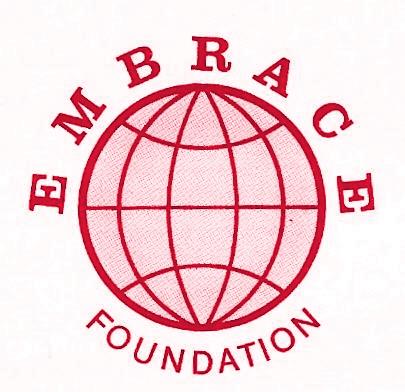
Embrace Foundation Retreat Center
Embrace.Foundation (skype messaging) - 011+1+212.675.4500 (New York)
Click to Email Us
